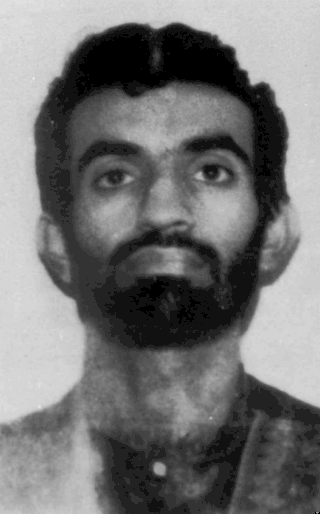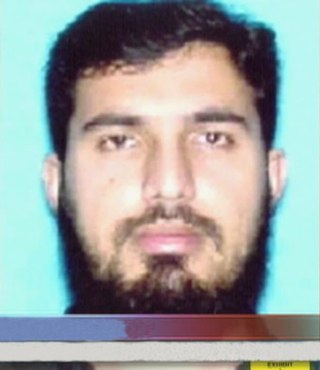Related Research Articles

Khalid Sheikh Mohammed, often known by his initials KSM, is a Pakistani terrorist, mechanical engineer and the former Head of Propaganda for the pan-Islamist militant group al-Qaeda. He is currently held by the United States at the Guantanamo Bay detention camp under terrorism-related charges. He was named as "the principal architect of the 9/11 attacks" in the 2004 9/11 Commission Report.

Daniel Pearl was an American journalist who worked for The Wall Street Journal. On January 23, 2002, he was kidnapped by Islamist militants while he was on his way to what he had expected would be an interview with Pakistani religious cleric Mubarak Ali Gilani in the city of Karachi. Pearl had moved to Mumbai, India, upon taking up a regional posting by his newspaper and later entered Pakistan to cover the war on terror, which was launched by the United States in response to the September 11 attacks in 2001. At the time of his abduction, he had been investigating the alleged links between British citizen Richard Reid and al-Qaeda; Reid had reportedly completed his training at a facility owned by Gilani, who had been accused by the United States of being affiliated with the Pakistani terrorist organization Jamaat ul-Fuqra.

Sulaiman Jassem Sulaiman Ali Abu Ghaith is a Kuwaiti regarded as one of al-Qaeda's spokesmen. He is married to one of Osama bin Laden's daughters. In 2013, Gaith was arrested in Jordan and extradited to the United States. In 2014, he was convicted in a U.S. federal court in New York for "conspiring to kill Americans and providing material support to terrorists" and sentenced to life imprisonment He is serving his sentence at the federal ADX Florence prison in Colorado.

Ramzi Ahmed Yousef is a convicted Pakistani terrorist who was one of the main perpetrators and the mastermind behind the 1993 World Trade Center bombing and the bombing of Philippine Airlines Flight 434; he was also a co-conspirator in the Bojinka plot. In 1995, he was arrested by the Pakistani Inter-Services Intelligence (ISI) and U.S. Diplomatic Security Service at a guest house in Islamabad, Pakistan, while trying to set a bomb in a doll, then extradited to the United States.

Adnan Gulshair el Shukrijumah was a citizen of Guyana and Saudi Arabia and a senior member of Al-Qaeda. He was born in Saudi Arabia and grew up in the United States.

Walid Muhammad Salih bin Mubarak bin Attash is a Yemeni prisoner held at the United States' Guantanamo Bay detention camp under terrorism-related charges and is suspected of playing a key role in the early stages of the 9/11 attacks. The Office of the Director of National Intelligence has described him as a "scion of a terrorist family". American prosecutors at the Guantanamo military commissions allege that he helped in the preparation of the 1998 East Africa Embassy bombings and the USS Cole bombing and acted as a bodyguard to Osama bin Laden, gaining himself the reputation of an "errand boy". He is formally charged with selecting and helping to train several of the hijackers of the September 11 attacks. On 31 July 2024, Attash agreed to plead guilty to avoid the death penalty. His plea deal was revoked by Secretary of Defense Lloyd Austin two days later.

Abderraouf bin Habib bin Yousef Jdey is a Canadian citizen, who was found swearing to die as a shaheed (martyr) on a series of videotapes found in the rubble of Mohammed Atef's house in Afghanistan in 2002.

Ammar al-Balushi or Amar Baloch; born Ali Abdul Aziz Ali on 29 August 1977) is a Pakistani (Balochi) citizen who has been in American custody at the Guantanamo Bay detention camp since 2006. He was arrested in the Pakistani city of Karachi in 2003 before being transferred; the series of criminal charges against him include: "facilitating the 9/11 attackers, acting as a courier for Osama bin Laden and plotting to crash a plane packed with explosives into the U.S. consulate in Karachi." He is a nephew of the Pakistani terrorist Khalid Sheikh Mohammed, who served as a senior official of al-Qaeda between the late 1980s and early 2000s; and a cousin of the Pakistani terrorist Ramzi Ahmed Yousef, who played a key role in the 1993 World Trade Center bombing, the Philippine Airlines Flight 434 bombing, and the high-profile Bojinka plot.
On September 11, 2001, 19 al-Qaeda terrorists took control of four commercial aircraft and used them as suicide weapons in a series of four coordinated acts of terrorism to strike the World Trade Center in New York City, The Pentagon in Arlington County, Virginia, and an additional target in Washington, D.C. Two aircraft hit the World Trade Center while the third hit the Pentagon. A fourth plane did not arrive at its target, but crashed into a field in Pennsylvania after a passenger revolt. The intended target is believed to have been the United States Capitol. As a result, 2,977 victims were killed, making it the deadliest foreign attack on U.S. soil, exceeding Japan's surprise attack on Pearl Harbor in Honolulu, Hawaii, on December 7, 1941, which killed 2,335 members of the United States Armed Forces and 68 civilians. The effort was carefully planned by al-Qaeda, which sent 19 terrorists to take over Boeing 757 and Boeing 767 aircraft, operated by American Airlines and United Airlines.
Alexandria City Jail is a jail facility at 2001 Mill Road, Alexandria, Virginia, serving several courts and police agencies in Northern Virginia, including the U.S. District Court for the Eastern District of Virginia, commonly called the Alexandria federal court.
Sheikh Ahmed Salim Swedan was a fugitive wanted in the United States as a participant in the 1998 U.S. embassy bombings. He was alleged to have purchased the Toyota and Nissan trucks used in the attacks, flying out of Nairobi to Karachi, Pakistan five days before the assault was launched. Swedan was on the FBI Most Wanted Terrorists list since its inception in October 2001. He was born in Mombasa, Kenya.
Ahmed Omar Saeed Sheikh is a British Pakistani terrorist. He became a member of the Islamist jihadist group Harkat-ul-Ansar or Harkat-ul-Mujahideen in the 1990s, and later of Jaish-e-Mohammed and was closely associated with Al-Qaeda.
Majid Shoukat Khan is a Pakistani who was the only known legal resident of the United States held in the Guantanamo Bay Detainment Camp. He was a "high value detainee" and was tortured by U.S. intelligence forces.
Christopher Paul is an American al-Qaeda militant, who has pleaded guilty to acts of terrorism. According to public data search, he is due to released on May 22, 2024 from RRM Cincinnati.
This page lists trials related to the September 11 attacks.
The 2009 New York City Subway and United Kingdom plot was a plan to bomb the New York City Subway as well as a target in the United Kingdom.

Najibullah Zazi is an Afghan-American who was arrested in September 2009 as part of the U.S. al Qaeda group accused of planning suicide bombings on the New York City Subway system, and who pleaded guilty as have two other defendants. U.S. prosecutors said Saleh al-Somali, al-Qaeda's head of external operations, and Rashid Rauf, an al-Qaeda operative, ordered the attack. Both were later killed in drone attacks.
At around 9:30 pm on September 11, 2001, George Tenet, director of the Central Intelligence Agency (CIA), told President George W. Bush and U.S. senior officials that the CIA's Counterterrorism Center had determined that Osama bin Laden and al-Qaeda were responsible for the September 11 attacks. Two weeks after the terrorist attacks on September 11, 2001, the Federal Bureau of Investigation connected the hijackers to al-Qaeda, a militant Salafist Islamist multi-national organization. In a number of video, audio, interview and printed statements, senior members of al-Qaeda have also asserted responsibility for organizing the September 11 attacks.
Uzair Paracha is a Pakistani citizen previously convicted of providing material support to al-Qaeda by a court in New York City in 2005. He received a 30-year prison sentence which was voided 18 years later, with his judge stating that letting his conviction stand was a "manifest injustice". In March 2020 the American government gave up on taking Uzair to trial again and he was released and repatriated after being imprisoned for 17 years.
References
- 1 2 "Ohio trucker joined al Qaeda jihad", CNN
- ↑ "Iyman Faris". globalsecurity.org. Archived from the original on 23 April 2020. Retrieved 14 June 2011.
- ↑ McPhee, Michelle (20 June 2003). "BROOKLYN BRIDGE PLOT Al Qaeda, Ohio trucker sought to destroy span". Daily News (New York) . Retrieved 16 June 2011.[ dead link ]
- 1 2 3 4 5 Pierre Thomas (September 8, 2003). "Officials Search for Terrorist Next Door". ABC News.
- 1 2 Eric Lichtblau (Oct. 29, 2003), "Trucker Sentenced to 20 Years in Plot Against Brooklyn Bridge", The New York Times
- ↑ "Judge strips terrorist of citizenship at government request". AP NEWS. 2020-02-05. Retrieved 2021-02-08.
- ↑ "Justice Department Secures Denaturalization of Convicted Terrorist Who Sought to Help al Qaeda Destroy the Brooklyn Bridge". www.justice.gov. 2020-02-04. Retrieved 2021-02-08.
- ↑ "Convicted terrorist who used to work in Columbus released from federal prison". wkyc.com. 28 August 2020. Retrieved 2021-02-08.
- 1 2 "Daily Telegraph". Telegraph.co.uk. June 23, 2003. Archived from the original on November 1, 2005.
- 1 2 "Kashmiri's arrest to put pressure on Pakistan". Dawn. 21 June 2003. Retrieved 20 March 2017.
- ↑ Officials Search for Terrorist Next Door, ABC News, September 8, 2003
- ↑ Ryan, Jason (3 June 2008). "Ohio Al Qaeda Member Admits WMD Plot". ABC News. Retrieved 3 May 2017.
- ↑ Susan Sachs (July 14, 2003). "Muslim "missionary" (sic) group draws new scrutiny in U.S." The Muslim News. Archived from the original on September 27, 2007.
- ↑ Daniel Klaidman (June 23, 2003). "Al Qaeda in America: The Enemy Within". Newsweek. Archived from the original on October 3, 2003. Retrieved December 26, 2015.
- 1 2 Eric Rich (May 16, 2007). "Terrorism suspect alleges mental torture". Washington Post.
- 1 2 "Iyman Faris Sentenced For Providing Material Support To Al Qaeda]". usdoj.gov. October 2003.
- ↑ "Man Tied to al-Qaeda Renegs Guilty Plea" [ permanent dead link ]
- ↑ James Risen and Eric Lichtblau (Dec. 16, 2005), "Bush Lets U.S. Spy on Callers Without Courts", The New York Times
- ↑ David Folkenflik (Dec. 16, 2005), "'Times' Held Story on U.S. Surveillance for a Year", NPR
- ↑ (2006), "James Risen and Eric Lichtblau of The New York Times", Pulitzer.org
- ↑ Eric Lichtblau and James Risen (Dec. 28, 2005), "Defense Lawyers in Terror Cases Plan Challenges Over Spy Efforts", The New York Times
- ↑ Wanja Eric Naef (June 14, 2004). "Somali Native Charged in a Bomb Plot, Ashcroft Says". iwar.org.uk.[ permanent dead link ]